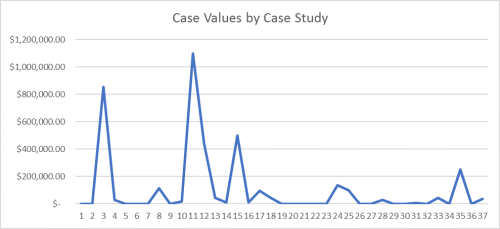In the 37-case sample of Achilles’ tendon injury cases, we saw five high-value outliers: $250,000, $443,089, $500,000, $835,000, and $1.1 million dollars. When we determined if a case qualified as an outlier for this sample, we examined each case’s trend relative to all the other cases, as well as their comparison to the average case value excluding defense verdicts and outliers. We found that most case values were $135,000 and under. This focused us to conclude that any value over $135,000 was an outlier. Figure 1 shows a line graph of the case values of each case in the sample where you can easily see the outlier, which is signified by the highest peaks of the graph.

Outliers are quantitative values that present as far above (or below) the average of any data set. These outliers point a researcher to scrutinize that value to determine why it would be irregular in terms of the regular trend of values seem in the set. In jury verdict research, outliers direct anyone analyzing jury verdicts to a case to analyze the facts of that case and determine why that case received a higher verdict or settlement in a jury trial setting than another comparable case. High-value outliers must be studied in terms of their ability to skew the average of a data set. Because outliers often cause the average case value of a sample to change, one must always calculate averages with and without the outliers for the most representative average of a data set.
EXAMPLES OF CASE OUTLIERS
Outlier cases commonly have explanatory facts which clarify their irregularity from the overall trend of the other cases in the sample. To demonstrate this, let’s look at some of the outliers from the sample beginning with the highest valued outlier.
EXAMPLE #1 – CASE STUDY 11
Case Study 11 presented us with a 35-year-old female plaintiff in Broward County whose trial took place in 2000. She suffered an Achilles’ tendon tear, a knee cartilage tear, and a knee strain which resulted in irregular walking when she tripped in a pothole and fell to the ground in the defendant’s parking lot. She alleged that the defendant failed to maintain the premises in a safe condition and failed to remedy or warn of the known dangerous condition. The defendant denied liability and contended that the condition was open and obvious and that the plaintiff failed to keep a proper lookout. This case was resolved in a comparative negligence verdict with the plaintiff receiving 10% of the negligence apportionment and the defendant receiving 90%. Further, the whole verdict of $1.1 million dollars, before negligence reduction, was given for pain and suffering.
Example #2 – Case Study 3
In Case Study 3, our second-highest valued outlier, we were presented with a 46-year-old female plaintiff in Manatee County whose trial took place in 1994. She suffered a ruptured left Achilles’ tendon, requiring surgery, and tendonitis, resulting in a 15% lower left extremity impairment after she was struck from behind by a cart being pushed by an employee of the defendant retail store, Wal-Mart Stores, Inc. She was pushed to the floor by the fully-stocked cart and alleged that the defendant’s employee failed to push the cart in a safe manner. The defendant admitted liability. This plaintiff received a true plaintiff’s verdict with an award of $853,000. Of this $853,000, $17,000 was given for past medical bills, $50,000 was given for future medical bills, $550,000 was given for pain and suffering, $126,000 was given for lost wages, and $110,000 was given to the plaintiff’s husband for loss of consortium.
Example #3 – Case Study 24
Lastly, our lowest-valued outlier presented us with a 49-year-old male plaintiff in Collier County whose trial took place in 2003. He was operating a motorcycle when he stopped for traffic at a red light. The defendant driver, who was operating a vehicle in the course and scope of his employment with the defendant company, was traveling directly behind the plaintiff when he failed to stop and rear-ended the plaintiff’s motorcycle. The plaintiff fell backward onto the hood of the defendant’s car and rolled off, striking his head on the fender. He suffered post-traumatic cervical/thoracic sprain/strain at C7 with a possible disc injury, post-traumatic lumbar strain/sprain, post-traumatic left rotator cuff impingement with a possible tear, and a contusion/hematoma involving the left Achilles’ tendon without incongruity. This case was resolved in a settlement for $250,000.
To learn more about the value attributed to all Achilles’ tendon injury cases, please click here.
For A Free Consultation Contact Us Now
Tallahassee: (850) 777-7777
Jacksonville: (904) 222-3333
Miramar Beach: (850) 203-5665





